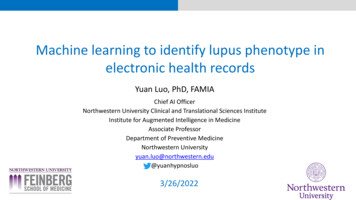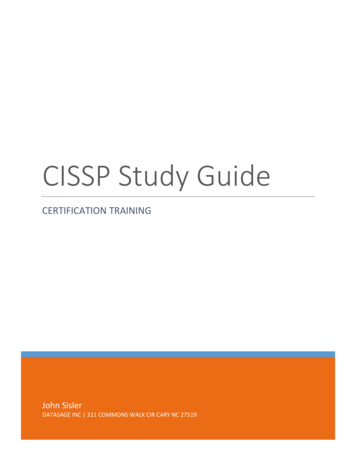
Transcription
Title PageSystemic Lupus Erythematosus: A review of the disease and treatment options1
Systemic Lupus Erythematosus: A review of the disease and treatment optionsAuthor PageSamuel L. Gurevitz, PharmD, CGPAssistant ProfessorPhysician Assistant ProgramCollege of Pharmacy and Health SciencesButler UniversityAddress:4600 Sunset AvenueIndianapolis, IN 46208Fax: (317) 940-6172Tel: (317) 940-6542Email: slgurevitz@hotmail.comJennifer A. Snyder, PA-C, DFAAPAAssociate ProfessorPhysician Assistant ProgramCollege of Pharmacy and Health SciencesButler UniversityEric K. Wessel, PA-SPhysician Assistant ProgramCollege of Pharmacy and Health Sciences2
Butler UniversityJulianne Frey, MS, RCEP, PA-SPhysician Assistant ProgramCollege of Pharmacy and Health SciencesButler UniversityBridgett A. Williamson, PA-SPhysician Assistant ProgramCollege of Pharmacy and Health SciencesButler UniversityDisclosures: No funding was received for this study or the development of the manuscript.The authors report no potential conflicts of interest.3
Systemic Lupus Erythematosus: A review of the disease and treatment optionsAbstractObjective: To provide an up-to-date review of the etiology, epidemiology, clinical features,diagnostic findings, and treatment options for systemic lupus erythematosus.Data Sources: A PubMed search of English language using a combination of words: elderly,systemic lupus erythematosus*, late onset systemic lupus erythematosus*, etiology, screening,diagnosis, or treatment to identify original studies, guidelines, and reviews on systemic lupuserythematosus, SLE, late onset systemic lupus erythematosus published between 2000 - present.Study Selection and Data Extraction: Overall original studies, clinical reviews, references, andguidelines were obtained and evaluated on their clinical relevance.Data Synthesis: The literature included guidelines and considerations for the etiology,diagnosis, screening, and management of systemic lupus erythematosus*, and late onset systemiclupus erythematosus.Conclusion: Systemic lupus erythematosus (SLE) is a chronic autoimmune disorder whereby theexact etiology is unknown. SLE predominately affects younger women; however, it is reportedto occur in up to 20% of patients 50 years or older. In patients with SLE, nearly every system inthe body is affected with varying degrees of severity ranging from subclinical to fatal. Thehallmark feature of SLE is the production of auto-antibodies directed primarily against nuclearantigens, but also against cytoplasmic components of cells. The diagnosis of SLE is based oncriteria set by the American College of Rheumatology. Management is individualized anddepends on presenting symptoms and reducing the likelihood of permanent damage to organsand tissues.4
Key Words: Elderly, Geriatrics, Late onset Systemic Lupus Erythematosus, Systemic LupusErythematosus, Treatment.AbbreviationsACEI Angiotensin Converting Enzyme Inhibitor, ACR American College of Rheumatology,ALT Alanine Transaminase, ANA Antinuclear antibodies, Anti-DNA Antideoxyribonucleic acid, Anti-dsDNA Anti-double stranded deoxyribonucleic acid, Anti-La/SSB Anti-La sjögren syndrome type B, Anti-RNP antibodies Anti-ribonucleoprotein, AntiRo/SSA Anti-Ro/Sjögren syndrome type A, Anti-Sm antibodies Anti-Smith antibodies, AST Aspartate Transaminase, CBC Complete Blood Count, CH50 50% hemolytic complement,COX-1 Cyclooxygenase-1, COX-2 Cyclooxygenase-2, EULAR European League AgainstRheumatism, GI Gastrointestinal, IV Intravenous, MTX Methotrexate, NSAIDs NonSteroidal Anti-inflammatory Drugs, RF Rheumatoid Factor, SLE Systemic LupusErythematosus, SLICC Systemic Lupus International Collaborating Clinic5
Systemic Lupus Erythematosus: A review of the disease and treatment optionsIntroductionSystemic lupus erythematosus (SLE) or lupus is a chronic, progressive, autoimmune disorderthat affects multiple organ systems, with a broad range of clinical and laboratorymanifestations.1-3 The term lupus means wolf in Latin and is named as such due to facial lesionsfound in the disease process that are reminiscent of a wolf's bite.4 This review will provide up-todate information regarding the etiology, environmental and genetic influences, clinical features,diagnostic findings, and treatment options for SLE.EtiologyWhile the etiology is unknown, there are several factors associated with the development of SLE(Table 1).1, 2, 5-8 Unexplainably, SLE patients do not clear apoptotic cells appropriately.2, 9 Thesecells release auto-antigens that may help drive the defective immune process.9 The complexinteraction between environment and immunologic factors in genetically susceptible individualsleads to continued deregulation of the innate and adaptive immune pathways with evidence ofauto-antibody secreting plasma cells and auto-antigen, hyper-reactive, memory B-cells.1, 7, 10-13Auto-antibodies often form long before clinical manifestations result in chronic, widespreadtissue and organ damage.2, 6, 14, 15 Patients with SLE experience acute exacerbations andremissions resulting in protean clinical and serologic manifestations.16,17SLE may develop as a result of exposure to medications. It is estimated that 10% of patientsdiagnosed with SLE may have drug induced lupus, and over 80 drugs (Table 2) have beenimplicated in the disease development.7, 16, 18-21Epidemiology6
SLE is most often initially diagnosed in young women of reproductive age but does affect those50 years of age or older.17,18, 22 Early diagnosis and treatment are important. The average time toreach a diagnosis is 2 years.7 However, in the late onset population, the average time to establishthe diagnosis is often as long as 5 years.23 Improvements in diagnostic techniques as well asmore intensive treatment methods have enhanced survival rates dramatically in recent years.24The survival rate has improved from a 4 year survival rate of 50% in the 1950’s to the presentday 20 year survival rate of approximately 80%.25-27The prevalence of SLE in the United States population is 14.6-68 /100,000.7 About 10 - 20% ofpatients will be diagnosed with late onset SLE (first diagnosed age 50 years or older) and willoften have more mild manifestations of the disease that may result in a delayed diagnosis.18, 23, 28The female predominance may not be as significant in the late-onset populations.23 Systemiclupus erythematosus is 2 to 4 times more common among African Americans and other nonwhite populations.17, 22Clinical ManifestationsLupus often follows a characteristic pattern of relapse and remissions and typically developsover an extended period of time.3, 5, 29 It takes careful observation to make the diagnosis. Theclinical presentation of SLE may be comprised of both systemic symptoms as well as specificsigns of organ-system dysfunction.3, 29 The incidence of clinical findings of early and late-onsetSLE may vary (Table 3).18, 28, 30Common presenting findings of patients with SLE are fatigue, malaise, fever, anorexia, andweight loss. They may present with an signs of systemic infection.5, 29 Patients may also presentwith a number of dermatologic findings, including discoid and malar lesions, photosensitivity,7
alopecia, periungual erythema, nailfold infarcts, and splinter hemorrhages.3,5,29 Thirty-fivepercent of patients withSLE will have some form of glomerulonephritis or nephrotic syndrome symptoms and signs onclinical examination, predicting a worse outcome.31 A renal biopsy is often suggested in patientswith renal complications to fully understand the extent of its severity.7Myalgias and muscle weakness are common. Up to 90% of patients with SLE present withsymmetrical joint pain, that is typically a migratory polyarthropathy, distinguished fromrheumatoid arthritis by its lack of joint destruction.3,5,29 The pathophysiology behindosteoporosis and the occurrence of fractures in SLE is multifactorial. It involves both diseaseand non-disease related factors, including complications of the treatment itself.32The most common cardiac findings are pericarditis and pericardial effusion.3, 5, 29, 33 Valvularabnormalities are frequent in patients with SLE, especially the mitral valve. Screening withtransthoracic echocardiography may be indicated in patients with SLE, especially for those withidentified risk factors such as corticosteroid use.33 SLE is also associated with an increased riskof coronary disease due to atherosclerosis.34The mechanism for neuronal damage is consistent with the autoimmune nature of SLE. Antineuronal antibodies attack neurons causing damage and neurologic symptoms such as stroke,seizures and peripheral neuropathy.5 Cognitive dysfunction is a common neuropsychiatricmanifestation of SLE as it is found in up to 80% of patients to a variable extent.35 Higher rates ofanxiety and depression are found in patients with SLE.36 Depression occurs more commonlywith changes in appearance and physical limitations due to complications or medication sideeffects.36 Health care providers should be alert for these manifestations.Diagnosis8
The clinical heterogeneity of SLE resulted in the development of classification criteria in 1982,and revised in 1997, by the American College of Rheumatology (ACR).37 The revision resultedin the establishment of 11 equally weighted criteria (Table 4), with 4 needing to be present forthe formal diagnosis of SLE.12, 38, 39 A subspecialist in rheumatology or nephrology maydiagnose a patient with only 3 criteria, if at least one is serologic and one is clinical.7 A patientcan be described as having “latent” or “incomplete” lupus with as few as one criterion andadditional common symptoms, such as fatigue, fever, alopecia or Raynaud’s phenomenon.7, 40-42Upon initial suspicion of SLE, the most important laboratory screening measure is the blood testfor antinuclear antibodies (ANA).7, 39 However, ANA is found in conditions other thanSLE; therefore, more specific tests are needed to help confirm the diagnosis, such as anti-dsDNA(anti-double stranded DNA), anti-Sm (anti-Smith) and antiphospholipid antibodies.38, 43 The antidsDNA and anti-Sm serological tests are considered definitive for lupus.7 Recent support hasbeen given to monitoring specific B-cell subsets as biomarkers of disease activity.13In 2009, the Systemic Lupus International Collaborating Clinic (SLICC) revised the ACR’sclassification criteria for SLE. The proposed classification “had better sensitivity than the ACR(94% vs. 86%), and roughly equal specificity (92% vs. 93%), and resulted in significantly fewermisclassifications (p .0082).”44 If validated, the SLICC criteria may become the standard in thediagnosis of this disease.TreatmentThere is no cure for SLE so early diagnosis and treatment to control dysfunction andcomplications are important. Management is individualized, depends on symptoms, and isdirected at reducing the likelihood of permanent damage to organs and tissues. Treatmentstrategies in late onset SLE do not differ widely from those seen in younger patients.18 The9
disease course in late onset SLE is usually mild requiring less use of cytotoxic/immunosuppressive drugs and high dose corticosteroids for disease control.18,30 Guidelines weredeveloped in 1999 by the ACR and in 2008 by the European League Against Rheumatism(EULAR) Task Force (Table 5).45,46 A major challenge in treating SLE is to inhibit clinicallyactive disease without causing long term consequences.18 Clinicians should be aware of druginteractions and adverse reactions are possible. This is especially true in the older patient as theyare more likely to be affected by multiple disease states and taking several medications. Inaddition, the pharmacokinetics and pharmacodynamics of drugs are often altered in the olderpatient. The safety profiles and monitoring recommendations for medications used in SLE areprovided (Table 6).15, 41, 45, 47- 51Non-pharmacologic ManagementBoth the ACR and EULAR recommend non-pharmacologic treatment in the management ofSLE. Patients should be counseled on lifestyle modifications, such as smoking cessation, weightcontrol, and increasing exercise to limit co-morbidities of atherosclerosis, hypertension, anddiabetes.45, 46 Patients should minimize sun exposure by wearing appropriate clothing, applyingtopical sunscreens, and avoiding tanning beds. Screening for bone loss should be instituted andtreatment commenced as needed.32 Patient education and psychosocial support are an importantaspect of management. Information about SLE and specific problems of living with the diseaseshould be combined with medical therapy to help alleviate depression and anxiety.52Unfortunately, challenges remain in increasing a patient’s quality of life.2, 36 Clinicians should bealert to changes in psychosocial functioning and treated and/or referred for appropriatecounseling as indicated.Pharmacologic Management10
Nonsteroidal Anti-inflammatory DrugsNonsteroidal Anti-inflammatory drugs (NSAIDs) are commonly used to relieve arthralgia,inflammation, serositis, and fever in patients with SLE. They can be used with or without lowdoses of steroids or antimalarial agents.41, 46, 47 NSAIDs inhibit the production ofcyclooxygenase-1 (COX-1) and cyclooxygenase-2 (COX-2).53 The inhibition of COX-1decreases the production of prostaglandins that protect the lining of the gastrointestinal tract. Theinhibition of COX-2 mediates the production of prostaglandins which moderates inflammationand pain. Therefore, NSAIDs that are selective COX-2 inhibitors, such as celecoxib, havereduced the occurrence of adverse gastrointestinal bleeding.53 In a study of 50 SLE patients withpredominance of musculoskeletal complaints and less severe organ involvement, celecoxib wasfound to be effective and safe.54Regardless of their cyclooxygenase selectivity, NSAIDs may cause renal impairment, fluidretention, and interstitial nephritis.47 Lupus nephritis is a risk factor for NSAID induced acuterenal failure55; therefore, NSAIDs should be used for the shortest effective period of timeespecially in patients with renal involvement, hypertension, or heart disease.46, 56HydroxychloroquineHydroxychloroquine, an antimalarial drug, is frequently used as a first line treatment option forpatients with mild SLE. It is effective in preventing the occurrence of new mild SLEmanifestations.15 A systematic review found antimalarials reduced lupus activity by more than50% in pregnant and non-pregnant patients and a greater than 50% improvement in mortality.51Hydroxychloroquine also has been shown to have a beneficial effect on dyslipidemia.57Hydroxychloroquine inhibits Toll-like receptors that cause a down regulation of interferon-α anddecreases the antigen processing for auto-antigen presentation.58 The safety profile for11
hydroxychloroquine is good. Retinal toxicity and macular damage can occur due to accumulationof the drug in ocular tissue;41, 47 therefore, the ACR recommends patients undergo a baseline eyeexamination before treatment and every 6 to 12 months thereafter.45 Hydroxychloroquine may beused during pregnancy.46GlucocorticoidsSystemic glucocorticoids are usually unnecessary in mild SLE, but low doses of prednisone 10mg/day or less are used if the patient has cutaneous and musculoskeletal symptoms notresponding to other therapies.45 Systemic glucocorticoids are used alone or in combination withother immunosuppressive agents for patients with significant organ involvement or refractorysymptoms.41, 47Due to the long term adverse effects of glucocorticoid treatment, the shortest effective durationshould be used.41, 47 Patients requiring long term glucocorticoid therapy should be monitored forthe complications of hypertension, diabetes, myopathy, psychosis, and cataracts.MethotrexateMethotrexate (MTX), an antifolate, may be preferred in the management of resistant arthritis andcutaneous SLE.15 Methotrexate provides a significant advantage in patients with moderatelyactive lupus by allowing lower steroid doses, and slightly decreasing lupus disease activity.59 In arecent prospective open label study, low dose MTX appears to be as effective as the antimalarialchloroquine, in patients with articular and cutaneous manifestations of SLE.60CyclophosphamideCyclophosphamide, an alkylating agent, is the standard of care for lupus nephritis and is usuallyused in conjunction with corticosteroids.41, 61 It is also used with corticosteroids in patients withsevere neuropsychiatric involvement.15, 6212
MycophenolateMycophenolate exerts its immunosuppressive effect by inhibiting B- and T-cell proliferation.47In a systematic review and meta-analysis, mycophenolate in combination with corticosteroidswas shown to be as effective as cyclophosphamide in the treatment of lupus nephritis and hadless risk of leukopenia.63 Maintenance therapy, either with azathioprine or mycophenolate, isrequired for periods of remission and prevention of relapse after the initial control of lupusnephritis. In a 36-month, randomized, double-blind, double-dummy, trial comparing oralmycophenolate mofetil and oral azathioprine, mycophenolate mofetil was superior toazathioprine in maintaining a renal response to treatment and in preventing relapse in patientswith lupus nephritis who had a response to induction.64AzathioprineAzathioprine inhibits DNA synthesis and prevents lymphocyte proliferation in the immunesystem.15, 41, 47 It is used as a steroid-sparing agent in moderate to severe lupus and in themaintenance phase of lupus nephritis.15, 47BelimumabBelimumab, a human monoclonal antibody, blocks the biologic activity of B lymphocytestimulator (BLyS/BAFF). This decreases the antibody levels in the body which may help reducethe autoimmune activity of SLE.41 Belimumab was approved by the FDA in 2011 for use inadults.7 In two phase III trials, BLISS-52 and BLISS-76, belimumab showed noteworthyimprovements in patients with SLE after 52 weeks, but the advances were not statisticallymaintained at week 76.15 Belimumab demonstrated a steroid-sparing effect in these trials as wellas a decreased rate of disease flares.65 To be included in the trial, patients had to meet the ACRcriteria for SLE, and they had to have active disease. Patients also had to demonstrate a positive13
ANA and be on a stable regimen of prednisone, NSAIDs, antimalarials, or immunosuppressivedrugs for 30 days prior to the start of the trial. Exclusion criteria included severe active lupusnephritis, CNS lupus, and pregnancy. Exclusion criteria also included prior therapy within thelast 3 months of IV cyclophosphamide, IV immunoglobulin, IV prednisone, or drugs that targetB-lymphocytes.65The safety profile for belimumab is good. Safety data from the BLISS trials demonstrated anadverse effect profile and infection rate similar to that of placebo in patients with a mean age of40 /- 12 years.7, 65, 66 There is no efficacy data in older patients. Patients on belimumab shouldnot receive live vaccines 30 days before, or during treatment due to a decreased ability to mountan immune response.49RituximabRituximab is a humanized chimeric mouse/human monoclonal antibody that targets the B-cellspecific antigen CD20. It leads to depletion of auto-reactive B-cells in the circulation of patientswith SLE.15, 47 Although not FDA approved, it is often used off label for severe refractory SLE.Unfortunately, placebo controlled trials in SLE failed to improve clinical outcomes.15, 67, 68Pharmacist’s Role Review the patient’s medications for drug induced lupus or for drug interactions (Table 27, 16,18-21and Table 7)48- 50, 69, 70 Monitor for adverse reactions and therapeutic response Ensure the patient is current on inactivated influenza and pneumococcal vaccines45 Monitor vitamin D levels and bone mineral density 71, 7214
o The majority of patients with SLE have insufficient levels of vitamin D. Thismay be due in part to less sun exposure, and medications used for the treatment ofSLE.o Patients on long-term glucocorticoids should receive sufficient daily calcium andvitamin D and/or a bisphosphonate to minimize the degree of bone loss.73 Review patient’s history to determine increased risk of NSAID-induced ulcerso The addition of a proton pump inhibitor or histamine-2 receptor blocker may beindicated Ensure that the patient is receiving daily supplemental folic acid to reduce side effectsrelated to the gastrointestinal system74 Confirm and make recommendations to ensure medications are administered correctlywith regard to meals and in relation to other medications.ConclusionSLE is a chronic autoimmune disorder whereby the exact etiology of which is unknown. SLEpredominately affects younger women; however, it is reported to occur in up to 20% of patients50 years or older. In patients with SLE, nearly every system in the body is affected with varyingdegrees of severity ranging from subclinical to fatal. The hallmark feature of SLE is theproduction of hyper-reactive, memory B-cells. Auto-antibodies are directed primarily againstnuclear antigens, but also against cytoplasmic components of cells. The diagnosis of SLE isbased on criteria set by the ACR. The management of SLE is largely a suppression of theimmune response, but should be individualized and dependent on presenting symptoms anddisease progression.15
16
References:1. Agmon-Levin N, Blank M, Paz Z et al. Molecular mimicry in systemic lupus erythematosus.Lupus 2009;18:1181–85.2. D’Cruz D, Khamashta M, Hughes G. Systemic lupus erythematosus. Lancet 2007;369:587–96.3. Porth C & Matfin G. Pathophysiology: Concepts of Altered Health States. 8th ed.Philadelphia, PA: Wolters Kluwer Health/Lippincott Williams & Wilkins; 2009.4. Boltzer JW. Systemic lupus erythematosus. I. Historical aspects. MD State Med J1983;32:439-41.5. Schur PH & Gladman DD. Overview of the clinical manifestations of systemic lupuserythematosus in adults. in: Basow, DS (Ed) UpToDate. Waltham, MA, 2012.6. Alarcon-Riquelme ME. The genetics of systemic lupus erythematosus. J Autoimmun2005;25:46-48.7. Bernknopf A, Rowley K, Bailey T. A review of systemic lupus erythematosus and currenttreatment options. Formulary 2011;46:178-94.8. Soldevilla H, Briones S, Navarra S. Systemic lupus erythematosus following HPVimmunization or infection. Lupus 2012;21:158-61.9. Bilj M, Reefman E, Horst G et al. Reduced uptake of apoptotic cells by macrophages insystemic lupus erythematosus: correlates with decreased serum levels of complement. AnnRheum Dis 2006;65:57–63.10. Dorner T, Jacobi A, Lee J et al. Abnormalities of B cell subsets in patients with systemiclupus erythematosus. J Immunol Methods 2011;363:187–97.17
11. Jonsen A, Bengtsson A, Nived O et al. Gene–environment interactions in the aetiology ofsystemic lupus erythematosus. Autoimmunity 2007;40:613–17.12. Tsokos G. Mechanisms of disease systemic lupus erythematosus. N Engl J Med2011;365:2110-21.13. Dorner T, Giesecke C, Lipsky PE. Mechanisms of B cell autoimmunity in SLE. Arthritis ResTher 2011;13:243.14. Sebastiani GD, Galeazzei M. Infection--genetics relationship in systemic lupuserythematosus. Lupus 2009;18:1169-75.15. Yildirim-Toruner C, Diamond B. Current and novel therapeutics in treatment of SLE. JAllergy Clin Immunol 2011;127:303-14.16. Zandmann-Goddard G, Solomon M, Rosman Z et al. Environment and lupus related diseases.Lupus 2012;21,241–50.17. Slawsky K, Fernandes A, Fusfeld L et al. A structured literature review of the direct costs ofadult systemic lupus erythematosus in the US. Arthritis Care Res 2011;63:1224-32.18. Arnaud L, Mathian A, Boddaert J et al. Late-onset systemic lupus erythematosus. DrugsAging 2012;3:181-89.19. Vedove CD, Del Giglio M, Schena D et al. Drug-induced lupus erythematosus. ArchDermatol Res 2009;301:99-105.20. Vasoo S. Drug induced lupus: an update. Lupus 2006;15:757-61.21. Marzano A, Vezzoli P, Crosti C. Drug-induced lupus: an update on its dermatologic aspects.Lupus 2009;18:935–40.22. Guillermo J, Pons-Estel G, Graciela S et al. Understanding the epidemiology and progressionof systemic lupus erythematosus. Semin Arthritis Rheum. 2010;39:257.18
doi:10.1016/j.semarthrit.2008.10.007.23. Font J, Pallares L, Cervera R et al. Systemic lupus erythematosus in the elderly: clinical andimmunological characteristics. Ann Rheum Dis 1991;50:702-5.24. Doria A, Iaccarino L, Ghirardello, A. Long-Term Prognosis and Causes of Death in SystemicLupus Erythematosus. Am J Med 2006;119:700-6.25. Merrill M, Shulman LE. Determination of prognosis in chronic disease illustrated bysystemic lupus erythematosus. J Chronic Disease 1955;1:12-32.26. Abu-Shakra M, Urowitz MB, Gladman DD, et al. Mortality studies in systemic lupuserythematosus. Results from a single centre. II. Predictor variables for mortality. J Rheumatol1995;22:1265-70.27. Urowitz MB, Gladman DD, Tom BD et al. Changing patterns in mortality and diseaseoutcomes for patients with systemic lupus erythematosus. J Rheumatol 2008;11:2152-58.28. Lazaro D. Elderly-onset systemic lupus erythematosus prevalence, clinical course andtreatment. Drugs Aging 2007;24:701–15.29. McPhee SJ & Papadakis MA. 2009 Current Medical Diagnosis and Treatment. 48th ed.NewYork, NY: McGraw-Hill; 2009.30. Lalani S, Pope J, de Leon F et al. Clinical features and prognosis of late-onset systemic lupuserythematosus: results from the 1000 faces of lupus study. J Rheumatol 2010;37:38-44.31. Gordon C, Jayne D, Pusey C et al. European consensus statement on the terminology used inthe management of lupus glomerulonephritis. Lupus 2009;18:257–63.32. Bultink I. Osteoporosis and fractures in systemic lupus erythematosus. Arthritis Care Res2012;64:2–8.33. Bourre -Tessier J, Huynh T, Clarke A et al. Features associated with cardiac abnormalities in19
systemic lupus erythematosus. Lupus 2011;20:1518–25.34. El-Magadmi M, Bodill H, Ahmad Y et al. Systemic lupus erythematosus an independent riskfactor for endothelial dysfunction in women. Circulation 2004;110:399-404.35. Adhikari T, Piatti A, Luggen M. Cognitive dysfunction in SLE: development of a screeningtool. Lupus 2011;20:1142- 46.36. Auerbach C, Beckerman N. What social workers in health care should know about lupus: astructural equation model. Health Soc Work 2011;36:269–78.37. Tan EM, Cohen AS, Fries JF et al. The 1982 revised criteria for the classification of systemiclupus erythematosus. Arthritis Rheum 1982;25:1271-77.38. Smith E, Shmerling R. The American College of Rheumatology criteria for theclassification of systemic lupus erythematosus: Strengths, weaknesses, and opportunities forimprovement. Lupus 1999;8:586-95.39. Egner W. The use of laboratory tests in the diagnosis of SLE. J Clin Pathol 2000;53:424-32.40. Hull C. Systemic lupus erythematosus: a clinical review. Clinician Reviews 2010;20:18-23.41. Kalunian K, Merrill JT. New directions in the treatment of systemic lupus erythematosus.Curr Med Res and Opin 2009;6:1501-14.42. Common symptoms of lupus. Lupus Foundation of America 2012. Available emplates/new learndiagnosing.aspx?articleid 2241&zoneid 524. Accessed May 9, 2012.43. Ginzler E. Systemic Lupus Erythematosus (Lupus), American College of RheumatologyPatient Fact Sheet, 2012. Available tients/diseases and conditions/lupus.asp.Accessed May 14, 2012.20
44. Petri M. Systemic Lupus International Collaborating Clinic ing/abstract.asp?MeetingID 761&id 8052.Accessed July 11, 2012.45. Gladman DD, Urowitz MB, Esdaile JM et al. Guidelines for referral and management ofsystemic lupus erythematosus in adults. Arthritis Rheum 1999;9:1785-96.46. Bertsias G, Loannidis JP, Boletis J et al. EULAR recommendations for the management ofsystemic lupus erythematosus. Report of a task force of the EULAR standing committee forinternational clinical studies including therapeutics. Ann Rheum Dis 2008;67:195-205.47. Amissah-Arthur MB, Gordon C. Contemporary treatment of systemic lupus erythematosus:an update for clinicians. Ther Adv Chronic Dis 2010;1:163-75.48. The Medical Letter Volume 10 (Issue15) March 2012.49. The Medical Letter Volume 53 (Issue 1366) June 2011.50. Cellcept (Mycophenolate mofetil) prescribing information. South San Francisco, CA:Genentech, USA; June 2012.51. Ruiz-Irastorza G, Ramos-Casals M, Brito-Zeron P, et al. Clinical efficacy and side effects ofantimalarials in systemic lupus erythematosus: a systemic review. Ann Rheum Dis 2010;69:20-28.52. Mazzoni D, Cicognani E. Social support and health in patients with systemic lupuserythematosus: a literature review. Lupus 2011;20:1117–25.53. Sostres C, Gargallo CJ, Arroyo MT. Adverse effects of non-steroidal anti-inflammatorydrugs (NSAIDs, aspirin and coxibs) on upper gastrointestinal tract. Best Pract Res ClinGastroenterol 2010;24:121-32.54. Lander SA, Wallace DJ, Weisman MH. Celecoxib for systemic lupus erythematosus: case21
series and literature review of the use of NSAIDs in SLE. Lupus 2002;11:340-47.55. Horizon AA, Wallace DJ. Risk:benefit ratio of nonsteroidal anti-inflammatory drugs insystemic lupus erythematosus. Expert Opin Drug Saf 2004;3:273-78.56. Scheiman JM, Hindley CE. Strategies to optimize treatment with NSAIDs in patients at riskfor gastrointestinal and cardiovascular adverse events. Clin Ther 2010;32:667-77.57. Tam LS, Gladman DD, Hallett DC et al. Effect of antimalarial agents on the fasting lipidprofile in systemic lupus erythematosus. J Rheumatol 2000;9:2142-45.58. Kuznik A, Bencina M, Svajger U, et al. Mechanism of endosomal TLR inhibition byantimalarial drugs and imidazoquinolines. J Immunol 2011;186:1-11.59. Fortin PR, Abrahamowicz M, Ferland D et al. Steroid-sparing effects of methotrexate insystemic lupus erythematosus: a double blind, randomized, placebo-controlled trial. ArthritisRheum 2008;59:1796-1804.60. Islam N, Hossain M, Haq SA et al. Effica
50 years of age or older.17,18, 22 Early diagnosis and treatment are important. The average time to reach a diagnosis is 2 years.7 However, in the late onset population, the average time to establish the diagnosis is often as long as 5 years.23 Improvements in diagnostic techniques as well as










